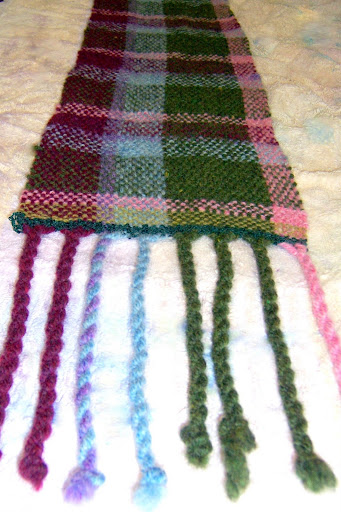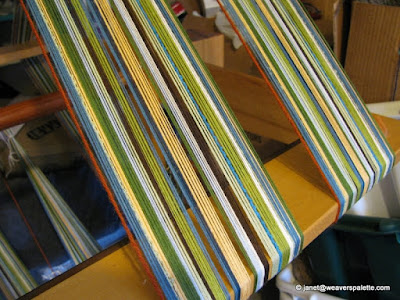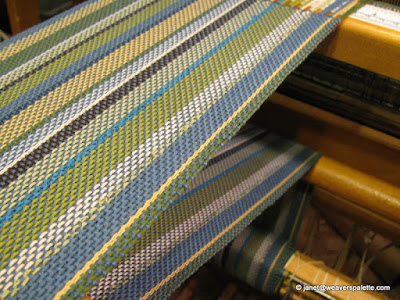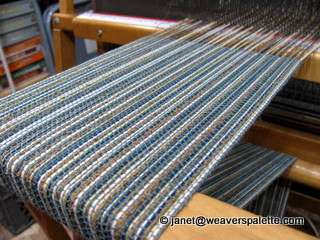A couple weeks after I started posting guest scarves, I got a little email from Linda Hurt: "On your blog you say you’d like to see beginners' scarves. I’ve got several in the making right now. I teach a Basic Weaving class in Alexandria, VA, and everyone has designed her own plaid and is weaving a scarf on a rigid heddle loom. I’d offer up pictures of these scarves for one of your Guest Fridays if you’re interested." Was I interested? You BET I was interested! I answered Linda right away and we agreed that, once her class was finished with their scarves, she'd write up a post about the class and send along some pictures.
I was particularly excited about this 'cause it's been a while since my guest scarf posts have been written by the weavers themselves rather than by me. My original idea for guest scarves was that people would tell their own stories, after all, so I was really eager to see what Linda would have to say. Let me tell you, when the "article" (as she called it) and her pictures arrived, I was totally blown away. Linda and her students put a tremendous amount of effort into their communal guest post. I am so touched that her students were willing to share the fruits of their labours with us and that so many of them took the time to share their thoughts on their scarves and on weaving in general. Ladies, thank you! Your scarves are just beautiful!
Although Linda had already gone well and truly beyond the call of duty where guest scarfing is concerned, I rather sheepishly sent her my short list of questions I'm hoping all future guest scarfers will answer and asked if she'd write just that little bit more for me. The thing is, this list of questions is in the same document as a laundry list of questions that I put together for guest scarfers just in case they suffered from writer's block and needed a little kick start - the idea being that they can pick and choose some questions from the list to answer just to get the juices flowing. I never dreamt that Linda would answer these too but answer them she did - every last one of them! I couldn't believe it. The woman is FAB.
Before we get to the guest scarves and all of Linda's responses to my questions, here's what she had to say about The Art League where she teaches. It sounds absolutely amazing:
"Our objective, as a non-profit art school, is to offer quality classes in several of the visual arts, including but not limited to drawing, painting, sculpture, pottery, surface design, weaving, and glass, at an affordable price to the community at large. We do not offer degree or certificate programs. Our classes are provided as a continuing education program. We also have various community outreach programs sponsored and conducted by our instructor staff, students, and friends of The Art League. We are currently expanding our fiber art offerings to include additional surface design and weaving options, wet and dry felting, knitting, crocheting, and sculptural fiber work. Our goal is to build a fiber art community.Wouldn't you just love to have access to a place like that? The Cape Breton Centre for Craft and Design, where I taught weaving for eight years, is a similar organization1 and has been a cornerstone of the craft community in this region for years. These kinds of organizations are so wonderful to be a part of and are so vital to the communities they serve.
The Art League, Inc., founded in 1954, is a multifaceted, nonprofit visual arts organization based in the Washington, DC metropolitan area and operated exclusively for charitable and educational purposes.
Headquartered on the Potomac River in Old Town Alexandria (in the Torpedo Factory Art Center), The Art League is celebrating over 50 years of devotion to promoting and maintaining high standards in fine art in the Washington, DC area. The Art League seeks to stimulate and encourage artists by operating a gallery with many opportunities for members, including monthly juried shows of members work, other chances for exhibition of work and many educational possibilities. The Art League also operates a school with 2000+ students per term and a supply store for the purchase of art supplies by students and members. The Art League currently has approximately 1000 members."
What follows is an introduction to the class itself by Linda, and then the comments of several of the students from the class along with pictures of their scarves. After that are Linda's answers to my laundry list in the now familiar interview format, interspersed with pictures of scarves by weavers who were no less generous with their projects but slightly more shy about writing something for the post. ;)
Incidentally, Linda took more pictures than have actually made it into the post. Each scarf is here at least once or twice, but you can see more pictures of dressing the looms and the scarves before and after wet finishing in Linda's online Picasa album.
And now, without further ado, I introduce to you all Linda Hurt and her co-guest-scarfers: Jan Adams, Melissa Burman, Hannah Chismar, Karen Downs, Pearl Ephraim, Rosalie Hanlon, Claudia Loaiza, Kathy Schneider, Lenora Stephens, Judy Sutton, Joanne Qualey, and Dianna White.
This week’s Friday Guest Scarfa feature is shared among the Basic Weaving students from The Art League, a non-profit art school in Alexandria, VA. This is a weaving survey class, beginning with tapestry techniques, and moving into pickup stick work, creating decorative floats across the surface of the piece. Then we experiment with open lace techniques such as Leno and Brooks Bouquet. The last exercises, balanced weave and color mixing, are worked into a scarf project. Students’ skills range from minimal weaving experience to none. Some have had no fiber background at all.
Judy Sutton -
I picked the blanket pattern from 'Rigid Heddle Weaving'2 because those are my favorite colors. I should have followed the pattern for all three segments, instead of only doing the outside two, so that I wouldn't have had to match the pattern after the second segment was woven. Unfortunately, they didn't match, but instead of one blanket I got two shawls. One I gave away to someone on the other coast, so it won't be seen again around here.
I loved weaving on the project because the colors pleased me and the weaving was relatively simple. I say relatively because the Harrisville Shetland is pretty sticky and it was sometimes a struggle to get a good shed.

I plan to keep weaving because I love the process, the planning, and the weaving and best of all the finished project. My hope is to master the entire process from sheep to wool, by dyeing the wool, carding it, spinning it, and weaving it. As Syne Mitchell says, "You've got to be warped to weave."3
Pearl Ephraim -
I did pick the ice blue color for my first scarf along with the stitching detail at the bottom because of one of the projects in Liz Gipson's book, "Weaving Made Easy." The garnet was chosen because it was the most attractive color available out of the wools. I liked it so well I used it on two of my three scarves.
As for what I did and didn't like about them: The first scarf, with the large patch of garnet I wasn't crazy about at first because it didn't look like a true plaid to me. It turned out to be asymmetrical with the lavender disappearing amongst the other colors. But it grew on me and became my favorite of the three scarves.
I tried to correct the lack of symmetry in the second scarf. But except for the golden yellow I thought the colors looked dull. You'll notice that they were my original earth tones. I do like the finish work of the knotted fringe at the end.
As for the third and final scarf, I over compensated again trying to get the look of the plaid correctly. The colors are repeated too frequently and the scarf is too busy. I can breathe a sigh of relief that the Easter egg look isn't so prominent any more. They'll grow on me I suppose. I will probably continuing weaving, at least for a while. I'm dying to try a twill.

I think I picked the colors (light and dark gray) I did because it seemed they kind of blend in with everything and look cool in every sense. The weaving class was a discovery for me as I never did anything like it before. Now that I have ordered a loom, I am looking forward to doing interesting projects.
Jan Adams -
The course was a great introduction to rigid heddle weaving. I've woven on floor looms, but the rigid heddle is perfect for my small home and it's so portable, too!
The plaid scarf project is something I probably never would have done on my own, so I appreciated the challenge. There were so many wonderful yarn colors to choose from, but I knew I wanted some brown, since I just purchased a brown coat! The blue and yellow complimented it, but jazzed it up, too.

It was especially fun to see the projects selected by the other students, and to confer with them on color choices, etc.

I purchased my own loom and I continue to weave. It is relaxing, creative and fun! There are lots of things one can make on the loom aside from scarves: table runners, placemats, wall hangings, shawls, etc.!
Diana White -
I took the class because I've always wanted to learn to weave. I'm a knitter, and also thought it might be an alternative way to use up some of my stash (or a better excuse to buy more yarn!!). The rigid heddle loom seemed like a manageable way to get started - small, portable loom and not too expensive. Although we spent more time on the tapestry aspect of weaving that I initially was interested in, I'm realizing how much those skills will contribute to future projects, and how frustrated I would have been had we jumped right in to specific projects. Bottom line, I wasn't ready for the scarf project until we got to it, but when we did, I sailed.

The colors I chose (dark teal, light blue, purple and white) are colors that always appeal to me and I thought worked well together and gave nice contrast. I couldn't be more pleased with the end result. I also think Linda was wise (experienced!) in suggesting we limit the number of colors for a first project. While I may want to expand the selection for future project, four colors provided enough interest, but also helped keep us from a warping nightmare.

I don't see myself moving to a larger loom any time in the foreseeable future, and I'm looking forward to weaving more scarves, napkins, and placemats on my RH loom. Next fall I plan to take another class to learn how to use two heddles for a fine yarn scarf.
Karen Downs -
I have been knitting for several years and wanted to learn something new. I have been interested in learning to weave for a couple of years. When I signed up for this class I had no idea what a rigid heddle loom was (never even heard of one) and walked into the class with no weaving knowledge at all. I liked learning tapestry weaving. The scarf project was a nice change of pace, balanced weaving is much faster.

I like my scarf but if I did the same style again, I would switch out the yellow for white or cream. I want to continue with the next class but will wait for the fall project class (maybe something like rag rug placemats). I have been involved in quilting too and have a lot a fabric to use up.

Joanne Qualey -
I loved the scarf project and have so many items in my wardrobe that are red, black or white that I thought a combination of those three colors for my plaid would work for me. I am pleased with the result.
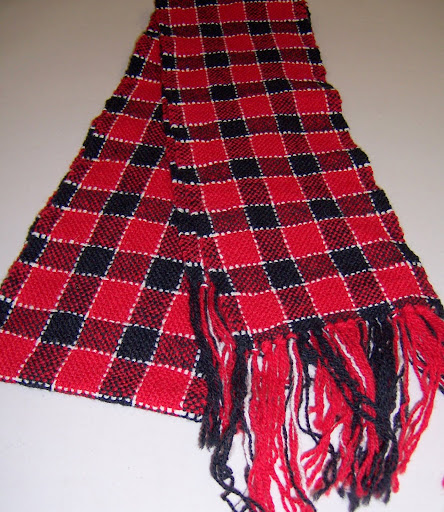
I will be continuing on in the Projects class, and I plan to purchase a rigid heddle loom. I have known for a long time that I wanted to learn weaving and now that my retirement is within reach (probably less than two years away) I want to be sure to have a creative hobby that I can develop more as I have more leisure time. I have always needed to create things to be happy and realize by taking this class that I have stayed away from making things far too long and allowed my work life to become way too all-consuming.
Rosalie Hanlon -
The pattern I chose is a variation of the MacGregor tartan. I chose this pattern because I thought the colours complimented each other well. I am a stickler for symmetry so even when I made a mistake I made sure to copy it on the other end of the scarf too!

The most difficult part for me was after the scarf was off the loom it was revealed that I had pig-tailed all of my ends instead of weaving them into the scarf. This meant I had to go back and weave them in using a needle, which took a very long time.
Linda Hurt -
Every quarter for about 10 years I’ve been teaching the Basic Weaving class for The Art League. Each class is so completely different that I just keep right on teaching. The people I meet are interesting and come from such varied backgrounds and professions (students, military, opera stars, physicians, house wives, nuclear physicists, retirees looking for a hobby, etc.) that I am always amazed. I continue to learn with each student from their choice of colors, their experiments, and their mishaps. It is probably from their mishaps I learn the most; it relieves me of the responsibility of having to make them all myself.
The plaid scarf project is a favorite of mine, because I get to see color combinations I might not choose. This is where I’ve learned the most valuable lesson: It is good to keep my opinions to myself sometimes and not influence color choices. (I do limit the color number to three or four.) In all of this time, I have not seen a bad combination of colors, and every single plaid has been successful. I am quite proud of these scarves that were created by this very lively and entertaining class. They kept me hopping for nine weeks.
JWD: What did you use for warp and weft?
LH: Harrisville Shetland or Highland weight was used for the student scarves.
JWD: How many ends per inch? Picks per inch?
LH: 8 or 10 epi depending on whether Harrisville Highland or Shetland weight was used.
JWD: What structure did you use?
LH: Plain weave was used for the student scarves. It’s appropriate for a first project. Personally, I think I could weave a lifetime and not exhaust its possibilities. (I’ve got a good start on that!) I do enjoy the game of adding heddles and pickup sticks to the mix.
JWD: How long and wide is the scarf?
LH: Most of the scarves were between 60 – 80 inches long. There was one shorter, because the student preferred short scarves. Then there was one that was even shorter, because we forgot to take into account the loom waste. However, it made the cutest and useful warm collar with a button and loop added. I call this “creative recovery.” [I love that! - jwd]

Lenora Stephen's scarf-into-collar. Definitely going to keep this in mind for my own oops-too-short-scarves!
JWD: How did you finish the fringe?
LH: Some people chose to twist the fringe just so they could use my battery operated hair twisters; some tied short fringe because they decided to weave as close to the end as possible; some wanted to learn how to hem stitch; some just preferred the look of one over the other for their particular scarf. [I have one of those hair twisters. A word to the wise: do not try them in your actual hair. "Ouch" is all I'm gonna say... - jwd]
JWD: What kind of loom did you weave on?
LH: Rigid heddle looms: Schacht traditional; Schacht Flip; Ashford; Beka; Glimakra Emelia
JWD: How did you warp the loom?
LH: The class uses the “direct warp” technique, which is fast and easy on rigid heddles with short warps. It’s good aerobic exercise walking back and forth too.
JWD: How did you come up with the idea for this scarf?
LH: The original lesson plans I inherited with the job called for weaving a short section of about 6 – 12 inches of a self-designed plaid as a color blending and plain weave exercise. I turned this into a final project, which has been generally popular. I’m flexible. If they don’t want a wool scarf, they can use cotton and make a bread cloth, hand towel, or small table runner.
JWD: Why did you pick the colours/fibres/structure/ design elements?
LH: A plain balanced weave was one of the objectives of this class. Colors were limited to four. Nobody picked my favorite color (chartreuse). Do you suppose they were politely leaving it all for me?
JWD: Is it a present for someone?
LH: So a couple of them said. Then they decided they really liked the scarves themselves. I wonder if they were ever “presented.”
JWD: Were you happy with the project? Would you weave it again?
LH: Everyone in this class was pleased with their scarves. Half of the class made more than one, in fact, one made a whole shawl as one of her pieces.
JWD: What was your favourite thing about weaving the scarf? Your least favourite?
LH: Most students like the speed at which they can do plain weave as opposed to the tapestry section of the class they had just finished.
JWD: What is your favourite thing about the finished scarf? Your least favourite?
LH: As a teacher, my favorite thing about this project is watching people pick out colors and put them together. I learn a lot here, as many people pick colors that I don’t usually work with. We all have our favorite colors. Some people mix colors I might not, and this broadens my viewpoint on color. I also like to see the smiles as the scarves are finished and people are proud of what they’ve done. Their excitement and pride is my reward.
JWD: Is this scarf like other things you've woven? How is it the same or different?
LH: Generally, I weave for class samples. Many times they’re whole shawls, scarves, table runners, towels, etc. But they are added to my chest of examples.
JWD: Did you do anything unusual (for you, or unusual in general) in this scarf?
LH: These scarves are first weaving projects for most of the class members. They designed the plaids themselves and wove them.
JWD: What do you have on the loom right now, or what's your next planned project?
LH: I have several rigid heddle looms. Though most are empty, I have the following in progress: shawl; heavy twill towel; SAORI banner; tapestry. I also have an overshot table runner on a 4-harness loom. On tablets I have a dog leash, necklace, shoe laces, sample band. On inkles I have a bag for my charkha and an Ikat band. [And she still finds time to teach and write me this amazing post! - jwd]
JWD: How long have you been weaving?
LH: About 12 years.
JWD: Do you weave other kinds of things? What's your favourite thing to weave? Why?
LH: Samples for classes I teach, because my time is severely limited. As I can eek out time, I’m trying to build up a “trunk” of items that showcase what different kinds of things can be done on rigid heddle looms.
JWD: What's your day job and what impact does it have on your weaving?
LH: Computer programmer, which is not a mere 40-hour a week job. It is more like 60 hours a week, and sometimes more. It often eliminates my time for weaving.
 Lenora Stephen's scarf on an Ashford Knitter's Loom. This is the kind of loom I'm getting in two (2) days!
Lenora Stephen's scarf on an Ashford Knitter's Loom. This is the kind of loom I'm getting in two (2) days!JWD: Do you pursue other fibre crafts such as spinning, knitting, crocheting, felting, quilting, etc etc etc?
LH: Oh, absolutely! Spinning, knitting, crocheting, felting (wet and dry), bobbin lace, lucet, Kumihimo, dyeing, tatting, nålbinding, sprang. [I don't even know what some of these are! - jwd]
JWD: Do you pursue other handcrafts that aren't fibre related?
LH: I used to, but there is just so little time. Well, sometimes indulge myself and play with beads.
JWD: Do you sell or exhibit your weaving or other handcrafts?
LH: No. I wish I had the time to make enough to be able to sell it and get a monetary return. At present, I have to be satisfied with hording my weavings for class examples.

And finally, here are Linda's answers to the much shorter list of questions I actually meant to ask her:
- Do you have a blog or other website(s) I can link to?
No. I wish I had the time to create one and manage it. I keep saying, “Some day.” Teaching fiber arts and working a full-time PLUS job forces me to make choices. Either I weave and maintain a website or I prepare samples, lessons and teach. - What is/are your favourite colour(s)?
Chartreuse. Orange is my second favorite. - What's your favourite fibre to weave with?
Wool - What's your favourite dimension (length and width) to weave a scarf?
72” x 10” - What are the dimensions of your favourite scarf? (the one you wear all the time, handwoven or otherwise)
72” x 10” - How did you find Scarf A Day?
Weavezine. Now I check it frequently. - What are 1-5 of your favourite websites and why do you like them? (they don't have to be weaving related!)
http://www.colorcombo.com/ac.html for web design work
http://www.tartanweb.org/designer/designer.php an online tartan generator.
There are several on line tartan generators, and my class enjoyed using them to design their plaids. We used to use graph paper and colored pencils. But these programs are much more fun to use and display results faster. “Faster” is expected in this day and age.
So there you are. Can you see why I was so blown away by all the effort that Linda and her possee of new rigid heddle weavers put into this post? I am SO delighted and SO touched! The guest scarves continue to be right at the top of the list of things I love about Scarf A Day, and this is a perfect example of why.
Linda, thank you! Jan, Melissa, Hannah, Karen, Pearl, Rosalie, Claudia, Kathy, Lenora, Judy, Joanne, and Dianna, thank you. And marvelous job on your scarves, shawls and collars, ladies!
One final related note: as I mentioned in the caption under one of Lenora's scarves, I'm getting an Ashford Knitter's Loom on Friday! Mom has been following along as I've asked for your input into various kinds of rigid heddles and helped me do a little research into the various types... and then, lo and behold, she learned that Donna Kaplan had an AKL that she hadn't ever used and was willing to send to a good home, so Mom nabbed it for me and is bringing it as my birthday pressie. Isn't it amazing how these things work? A couple months ago I had zero (0) interest in rigid heddle weaving but then all these great guest scarves started turning up in my inbox, woven on rigid heddles... then, no sooner do I express an interest in getting one of these babies for myself when a perfect one lands in my lap! And not just any loom, but one previously loved (if slightly neglected) by Donna Kaplan, whose work I just love (and whose workshop I just loved at Convergence 2002). Yay for karma! Yay for mothers! Yay for birthday looms!
You can be 110% sure that I'm taking yarn with me to Halifax and, just as soon as I smooch my dear ol' Mum hello and make sure she's comfy in her hotel room, I'll be warping that loom right in my hotel room. Or hers if she's not too tired!
She's a weaver. I'm pretty sure she'll understand...
1. Albeit on a somewhat smaller scale. Smaller population base around here, doncherknow.
2. I'm not sure which Rigid Heddle Weaving this is. It might be this one, or perhaps this one, or some other book entirely! Judy, can you help me out?
3. This is a reference to Syne's sign-off at the end of every WeaveCast episode. If you aren't already a WeaveCast listener, you should be!
